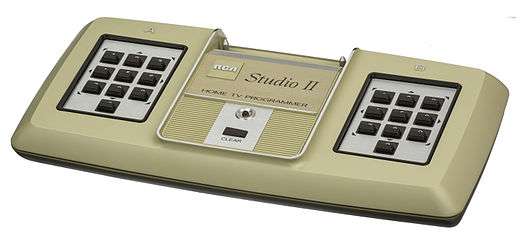RCA Studio II
 RCA Studio II | |
| Manufacturer | RCA |
|---|---|
| Type | Home video game console |
| Generation | Second generation |
| Release date | January 1977 |
| Introductory price | US$149 (equivalent to $601.73 in 2017) |
| Discontinued | 1978 |
| CPU | RCA 1802 microprocessor, 1.78 MHz |
| Removable storage | ROM cartridge |
| Controller input | Ten-button keypads |
The RCA Studio II is a home video game console made by RCA that debuted in January 1977. The graphics of Studio II games were black and white[1] and resembled those of earlier Pong consoles and their clones. The Studio II also did not have joysticks or similar game controllers but instead used two ten-button keypads that were built into the console itself.[2] The console was capable of making simple beep sounds with slight variations in tone and length. The Studio II included five built-in games.[3]
The console's switchbox relayed both the modulated RF signal of the console's video to the television set while powering the console with DC power. This type of switchbox would not be seen again until the Atari 5200.
The Studio II was not a successful product; the previously released Fairchild Channel F made it obsolete at launch and it suffered a final decisive blow when the superior (to both) Atari 2600 console was released only 10 months later. After poor Christmas sales in 1977, RCA ceased production of the Studio II and offloaded excess inventory to Radio Shack in a fire sale.
Development
RCA engineer Joseph Weisbecker began building his own personal computer at home in the late 1960s, and encouraged the company to sell small computers. RCA introduced the Studio II video game console—using Weisbecker's COSMAC 1802 CPU—in January 1977.[4]
Joyce Weisbecker, the daughter of the console's designer, learned how to program her father's homemade home computer as a child. After graduating from high school in 1976, she used her familiarity with the architecture to create School House I and Speedway/Tag for the Studio II, becoming the first woman to develop a commercial video game.[4]
Market loss
The Studio II sold poorly. An internal sales document put RCA's own sales estimate for the console between 53,000-64,000 units sold between February 15, 1977 and January 31, 1978[5]. It was released after the superior Fairchild Channel F, and the very successful Atari 2600 also appeared in 1977. RCA announced the console's discontinuation in February 1978[4] because of low Christmas sales. While losses were not disclosed, the company laid off 120 workers at its plant that produced the system in North Carolina. Some analysts blamed the fact the RCA Studio II's games were in black and white, and could not compete with systems offering color.[6]
System specs


- RCA 1802 microprocessor, 1.78 MHz
- 2 KB ROM (includes the five built-in games)
- 512 bytes RAM
- RCA CDP1861 "Pixie" video chip, 64x32, monochrome graphics [7]
Studio II built-in games
- Addition
- Bowling
- Doodle
- Freeway
- Patterns[7]
Released Studio II cartridge games
- 18V400|TV Arcade I: Space War
- 18V401|TV Arcade II: Fun with Numbers
- 18V402|TV Arcade III: Tennis/Squash
- 18V403|TV Arcade IV: Baseball
- 18V404|TV Arcade Series: Speedway/Tag
- 18V405|TV Arcade Series: Gunfighter/Moonship Battle
- 18V500|TV School House I
- 18V501|TV School House II: Math Fun
- 18V600|TV Casino I: Blackjack
- 18V601|TV Casino Series: TV Bingo (very limited release)(only 2 copies are known to exist as of 1/7/2018)
- 18V700|TV Mystic Series: Biorhythm
List of carts released on the MPT-02 clones (France/Australia)
- MG-200 Grand Pack (Doodle, Patterns, Blackjack and Bowling)
- MG-201 Bingo
- MG-202 Concentration Match
- MG-203 Star Wars
- MG-204 Math Fun (School House II)
- MG-205 Pinball
- MG-206 Biorythm
- MG-207 Tennis/Squash
- MG-208 Fun with Numbers
- MG-209 Computer Quiz (School House I)
- MG-210 Baseball
- MG-211 Speedway/Tag
- MG-212 Spacewar Intercept
- MG-213 Gun Fight/Moon ship
List of carts released on the Visicom COM-100 clone(Japan)
- CAS-110 Arithmetic drill (Math Fun & Fun with Numbers)
- CAS-130 Sports fan (Baseball & Sumo Wrestling)
- CAS-140 Gambler I (Blackjack)
- CAS-141 Gambler II (Slot Machine and Dice)
- CAS-160 Space Command (Space War)
- CAS-190 Inspiration (Bagua and Biorhythm)
Other
- M1200-05 Star Wars (Sheen M1200)
- M1200-07 Pinball (Sheen M1200) or Flipper (German Clone)
References
- ↑ Kent, Steven L. (2001). The Ultimate History of Video Games. Three Rivers Press. ISBN 0-7615-3643-4.
- ↑ https://books.google.com/books?id=5eIDAAAAMBAJ&pg=PA92&dq=atari&hl=en&sa=X&ved=0ahUKEwiH3anlmI3QAhWFxVQKHf45Cfk4FBDoAQgeMAE#v=onepage&q=atari&f=false
- ↑ Dillon, Roberto (2011). The Golden Age of Video Games. A K Peter/CRC Press. ISBN 978-1-4398-7323-6.
- 1 2 3 Edwards, Benj (2017-10-27). "Rediscovering History's Lost First Female Video Game Designer". Fast Company. Retrieved 2017-10-27.
- ↑ http://atariage.com/forums/topic/209519-rca-studio-ii-gold-mine-an-interview-with-the-studio-2-production-manager/page-47#entry3872359
- ↑ TV Games Cutback, Page 21, Spokane Daily Chronicle, 1978-02-14, Spokane Daily Chronicle - Google News Archive Search
- 1 2 "RCA Studio 2 Technical Information". Archived from the original on 2009-04-15.
External links
- History of Home Video Games - RCA Studio II
- The Dot Eaters article, featuring the RCA Studio II
- Emma 02 including RCA Studio II Emulator